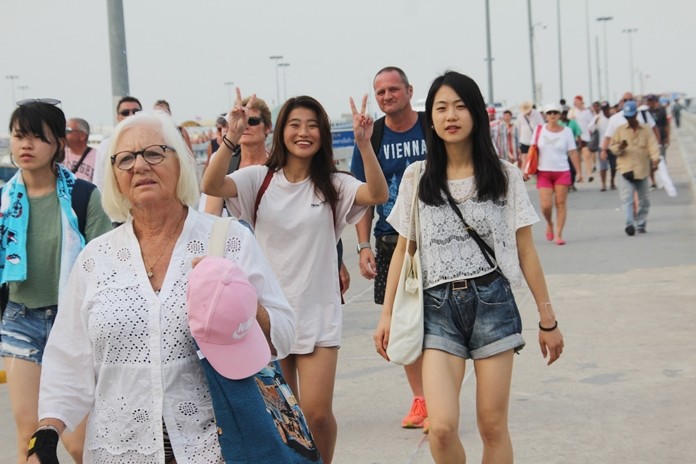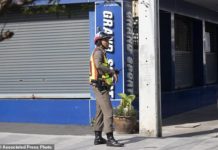Bangkok’s tourism industry is reeling under the aftermath of the pandemic and officials want to open more destinations to tourists, despite rising COVID cases.
When Sunisa (name changed) learned that the Thai government had greenlit plans to reopen Phuket, the country’s most popular resort island, under the pilot scheme to revive tourism, she was overjoyed.
Like many, the pandemic has derailed her ability to earn a living. Before coronavirus, she was usually busy running a private tour operator for families and small groups, offering a one-stop service from accommodation to transportation and excursions.
“I thought the ‘Phuket Sandbox’ program would help bring back visitors and it was as I had expected,” the 50-year-old told DW. “Some clients have returned and my income has begun to improve.”
While the number is nothing compared to what she used to make, Sunisa is hopeful about the upcoming peak season from December to March as new bookings started to come in.
‘Unpredictable and complicated’
Since July 1, overseas tourists have been able to visit the resort island without having to quarantine, provided that they are fully vaccinated and are willing to obey an extensive list of regulations in place to safely revive an industry that is in desperate need of rescuing.
After staying in the area for 14 days, they are allowed to travel on to other parts of Thailand. But visitors have been put off by the Thai government’s unpredictability of COVID regulations and complicated paperwork.
Just over 26,000 travelers have visited Phuket through the Sandbox program in the first two months, well short of the 100,000 it was hoped would have visited by the end of September.
While the numbers have fallen short of forecasts, officials are still hopeful the trickle of visitors can become a stream. (continues)
Salvaging tourism industry
Like other tourism-dependent nations, Thailand’s tourism sector, which made up 20 percent of national income, has been hammered by the coronavirus.
As much of the world struggled to contain the first waves of the pandemic, Thailand escaped last year relatively unharmed, although only by shutting its borders and in turn, its tourism industry.
But the Delta variant has seen infections, hospitalisations and deaths skyrocket since April, postponing any plans to reopen fully.
At the start of September, officials eased local lockdowns, including in the capital Bangkok, that were in place to contain outbreaks in order to boost business, despite infection rates remaining high.
The move signals a tactical shift from authorities who are now hoping to keep the contagion at manageable levels and attempt to return to normalcy.
So despite the alarming coronavirus caseload, Thailand is pressing ahead with plans to extend its ‘Sandbox’ initiative to more provinces, which include the capital Bangkok, the northern city of Chiangmai, and beach resorts like Pattaya, Cha-An and Hua Hin.
Struggling to stay afloat
Hotels, small and large across the nation, are one of the hardest-hit industries by COVID-19 and have seen business evaporate due to the lack of visitors.
A recent survey by the Bank of Thailand and the Thai Hotels Association (THA) found that 52% of hotel operators were considering closing their doors temporarily while 9% wanted to shut down permanently. (continues)
Small players in particular are feeling the strain. Normally, Sawita Vibhatasilpin and her business partner would see 20-30 backpackers coming in and out of their small yet lively hostel in downtown Bangkok everyday.
But since authorities shut borders last year to contain the coronavirus, there is now plenty of space in the hostel as the number has significantly dropped to 1-2 travelers per month.
Small, independent budget backpacker hostels like hers are hard-pressed to survive the COVID-19 outbreak. Two other hostels in the same neighborhood have already gone out of business and Sawita worries that a similar fate might befall them.
“I’m afraid that we will eventually be forced to close down. While the landlord has been understanding, we have barely made any money and haven’t paid any rent for the past six months,” the 30-year-old said.
Waiting for better days
While the situation has improved slightly for some, there’s still a long road ahead until tourist arrivals to Thailand recover fully.
“I had zero bookings until the past 4-5 months when some domestic tourists started trickling back,” Nattakit Malaichaisong told DW.
“But I really doubt we can actually reopen in October. Less than 20% are fully vaccinated and the daily caseload is still high.” (continues)
A tour guide in Chiangmai, one of the country’s most popular destinations, Nattakit was used to picking up tourists as early as 5 am for excursions and having hardly any time to rest but these days, he is spending most of his time at home, raising his two-year-old kid with his wife.
“Before the pandemic hit, the demand for my services was so high I was working non-stop for three months as it was the high season,” said the 39-year-old.
Tourism Minister Phiphat Ratchakitprakarn told local media last month that if the delta-driven outbreak continues beyond September, the country can expect a mere 500,000-700,000 foreign visitors this year.
The Tourism Authority of Thailand was more optimistic, forecasting 1.2 million international tourists would travel to the country this year.
But even that more hopeful outlook pales compared to 40 million international travelers who visited the country back in 2019 before COVID.
“I think we might have to wait for another year or two until travel really bounces back,” said Nattakit. “Restoring visitors’ confidence and keeping tourists safe are key.”










































